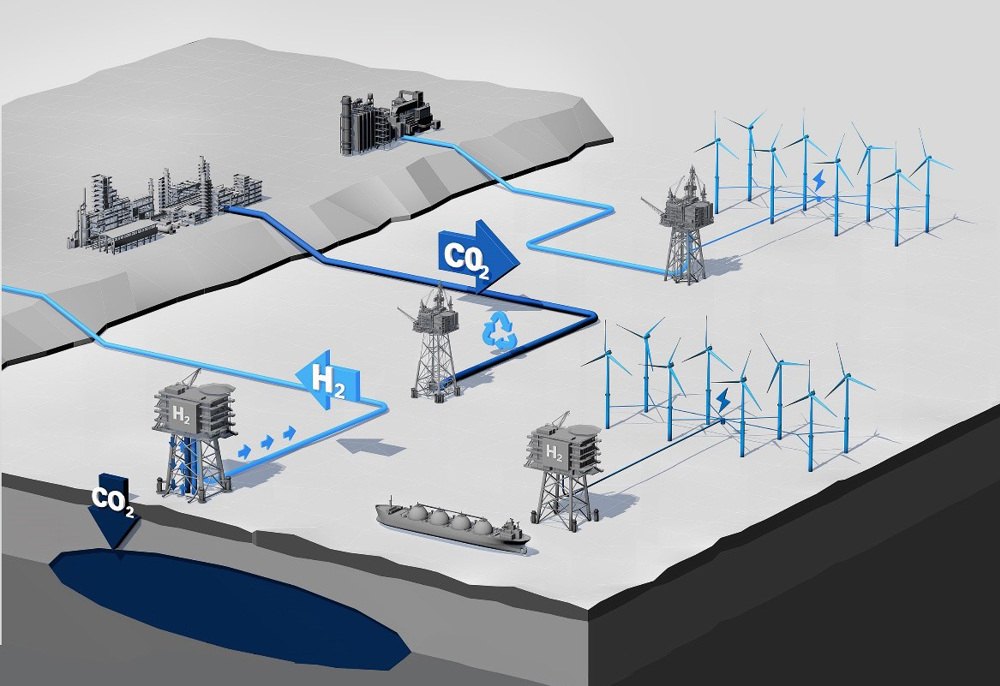
Carbon Capture and Storage (CCS) is critical to the UK achieving net zero.
What is CCS?
CCS refers to a variety of processes which capture and store carbon dioxide emissions, generally from industrial processes. The carbon dioxide can then be transported, including via repurposed gas pipelines, and stored, for example within rock formations in the UKCS, including depleted oil and gas reservoirs.

Facts
Our Energy Integration Project illustrates that integration of offshore energy systems, including CCS, could deliver around 30% of total carbon reduction requirements needed to meet 2050 net zero target.
75-180 million tonnes of CO2/year captured and stored by 2050, or up to one third of the current UK emission baseline (CCC 2020) The Sixth Carbon Budget: The UK's path to Net Zero)
Up to 78 billion tonnes of CO2 potential storage capacity on the UKCS, sufficient to meet hundreds of years of UK demand (British Geological Survey, co2stored.co.uk)
NSTA Role
- Licensing and permitting authority for offshore carbon storage
- Stewardship of issued carbon storage licences
- Collaboration with other key external bodies, including on spatial coordination
- Using our technical expertise to build a portfolio of carbon storage opportunities
- Consultee to OPRED on operators’ decommissioning plans
- Maintain carbon storage public register
Working with government and industry
- Supporting government and others to identify existing infrastructure with reuse potential for carbon capture and storage or hydrogen projects
- Engaging with CCS project developers
- Guiding and stewarding project developers and applicants through NSTA processes
What CCS projects are there?
-
There are twenty-seven carbon dioxide (CO2) appraisal and storage licences on the UK Continental Shelf, the details of which can be found on the carbon storage public register here.
Further details about the licensing regime and the carbon storage public register can be viewed here.

On 30th April 2024, the NSTA opened a competitive process inviting applications for Carbon Dioxide Appraisal and Storage Licences in an area in the English Channel. These licences grant exclusive rights for the exploration and appraisal of potential storage sites for carbon dioxide in the subsurface. Applicants had to note their interest in submitting an application within the first two weeks of the process, and had to submit applications by Wednesday 5th June 2024.
The NSTA will subsequently undertake technical evaluations of applications received, and OPRED will make an Appropriate Assessment under the Habitats Regulations.
Full information on the process can be found here.
The NSTA launched the UK’s first carbon storage licensing round on 14 June 2022 and closed on 13 September 2022, inviting applications for a number of areas across the UKCS including the Northern North Sea, Central North Sea, East Irish Sea and Southern North Sea. On 18 May 2023 the NSTA offered for award 20 carbon storage licences at offshore sites. On 15 September 2023 the NSTA announced the list of companies which have accepted licences.
Information on the round can be found here.
On 10 October 2023, the Seismic Imaging within the UKCS Energy Transition Environment report was published. It examines the vital and growing role that technology can play in studying the seabed and assessing potential uses of different areas of the North Sea.
The work is of particular importance now as 21 carbon storage licences have recently been awarded and the NSTA estimates that up to 100 carbon storage licences in total will be needed in the near future to meet sequestration targets, and the continuing development of offshore wind.
The carbon storage sites, in particular, will require redevelopment of large areas of the UK’s subsea geological basins and the new report chiefly looks at the various seismic and geophysical tools available to help ensure that developments are carefully planned and conducted with full consideration of interactions with other marine sectors.
Read the report here.
The NSTA published a technical report resulting from an internal study into the role of Measurement, Monitoring and Verification (MMV) for carbon storage sites, with a particular emphasis on monitoring those sites with restricted access owing to co-location with other seabed infrastructure users (e.g. wind farms). The report is intended to provide both high level industry guidance and detailed examples of the type of technology to be considered around a carbon storage site. The report can be downloaded here.

